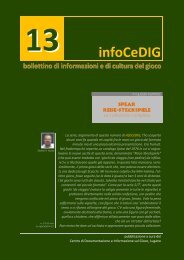GIOCHI [in generale] - Centro di Documentazione e Informazione ...
GIOCHI [in generale] - Centro di Documentazione e Informazione ...
GIOCHI [in generale] - Centro di Documentazione e Informazione ...
You also want an ePaper? Increase the reach of your titles
YUMPU automatically turns print PDFs into web optimized ePapers that Google loves.
Vandoni R.<br />
BRIDGE, IL (3VV.)<br />
L'Airone, Roma, 2004-2006<br />
<strong>Centro</strong> <strong>di</strong> <strong>Documentazione</strong> e <strong>Informazione</strong> sul Gioco [CeDIG] — Catalogo bibliografico<br />
Primo volume. Come imparare bene e velocemente<br />
le regole essenziali del gioco [2004, 124p.]<br />
[L'autore] | Introduzione | [14 "<strong>di</strong>scussioni"]<br />
Secondo volume. Le tecniche fondamentali per un <strong>in</strong>cisivo<br />
gioco della carta [2005, 118p.]<br />
[L'autore] | Nota <strong>in</strong>troduttiva | [12 "<strong>di</strong>scussioni"]<br />
Terzo volume. Come perfezionare il sistema delle <strong>di</strong>chiarazioni,<br />
rendendolo più efficiace e più competitivo<br />
[2006, 119p.]<br />
[L'autore] | Nota <strong>in</strong>troduttiva | [11 "<strong>di</strong>scussioni"] | Risposte<br />
agli esercizi<br />
I sottotitoli del 2° e 3° volume appaiono solo <strong>in</strong> copert<strong>in</strong>a.<br />
LIBRI DI APPROFONDIMENTO<br />
Cohen L.<br />
TO BID OR NOT TO BID [IDEM]<br />
Mursia, Milano, 1995, 239p.<br />
Prefazione (M. Bergen) | Prefazione alla seconda<br />
e<strong>di</strong>zione (N. Ghelli) | Premessa | 1. Che cos'è la legge<br />
delle prese totali? | 2. Come si applica la legge | 3.<br />
Piccole rif<strong>in</strong>iture | 4. Al livello giusto | 5. Oltre il livello<br />
giusto | 6. Contrare o non contrare? | 7. La legge a<br />
senza atout | 8. Le massime della legge | 9. I fattori <strong>di</strong><br />
correzione | 10. Dove sono i <strong>di</strong>fetti? | 11. La legge nel<br />
mondo | Glossario | Appen<strong>di</strong>ce A. Punteggio duplicato<br />
| B. Tavola IMP<br />
Di Stefano F./Alkalaj I.<br />
GUIDA PRATICA ALLA DICHIARAZIONE<br />
Mursia, Milano, 1993, 103p.<br />
Prefazione | 1. Pr<strong>in</strong>cipi del naturale moderno e vari<br />
tipi <strong>di</strong> apertura | 2. Apertura <strong>di</strong> uno a colore | 3. Apertura<br />
<strong>di</strong> 1 SA | 4. L'apertura <strong>di</strong> 2 SA | 5. L'apertura <strong>di</strong><br />
due a colore | 6. Aperture <strong>di</strong> 2 fiori convenzionali | 7.<br />
L'apertura <strong>di</strong> barrage | 8. Le <strong>di</strong>chiarazioni <strong>di</strong> <strong>in</strong>tervento<br />
| 9. La riapertura | 10. Dichiarazioni dopo l'<strong>in</strong>tervento<br />
dell'avversario | 11. Gli accostamenti allo<br />
slam | Guida pratica alla <strong>di</strong>chiarazione | In<strong>di</strong>ce delle<br />
tavole<br />
Contiene sagoma <strong>in</strong> cartone da utilizzare con le tavole.<br />
Federazione Italiana Bridge (ed.)<br />
STANDARD ITALIA<br />
Mursia, Milano, 1988, 415p.<br />
Presentazione (G. Rona) | Introduzione (N. Ghelli) | I.<br />
Standard Italia (a cura <strong>di</strong> G. Belladonna, F. Di Stefano e<br />
C. Pabis-Ticci) | 1. Premesse | 2. Le aperture <strong>di</strong> uno a<br />
— 151 —<br />
colore | 3. Risposte all'apertura <strong>di</strong> 1 a colore | 4.<br />
Seconda <strong>di</strong>chiarazione dell'apertore | 5. Seconda<br />
<strong>di</strong>chiarazione del rispondente dopo la risposta <strong>di</strong> 1 s.a.<br />
| 6. Seconda <strong>di</strong>chiarazione del rispondente dopo la<br />
risposta <strong>di</strong> 1 a colore | 7. Seconda <strong>di</strong>chiarazione del<br />
rispondente dopo una risposta positiva senza salto | 8.<br />
Seconda <strong>di</strong>chiarazione del rispondente dopo una<br />
risposta positiva a salto | 9. Risposte all'apertura dopo<br />
<strong>in</strong>terferenza avversaria | 10. Apertura <strong>di</strong> 1 s.a. | 11.<br />
Apertura <strong>di</strong> 2 s.a. | 12. Apertura <strong>di</strong> 2 quadri, 2 cuori, 2<br />
picche | 13. Apertura <strong>di</strong> 2 fiori | 14. Apertura <strong>di</strong><br />
barrage | 15. Interferenze su apertura avversaria | 16.<br />
Dichiarazioni <strong>di</strong> accostamento allo slam | II. Guida<br />
pratica allo standard | 1. Dichiarazioni <strong>di</strong> apertura | 2.<br />
Dichiarazione <strong>di</strong> 1° giro del rispondente | 3.<br />
Dichiarazioni <strong>di</strong> 2° giro dell'apertore | 4. Dichiarazioni<br />
<strong>di</strong> 2° giro del rispondente | 5. Risposte all'apertura <strong>di</strong> 1<br />
a colore <strong>in</strong>terferita | 6. Risposte all'apertura <strong>di</strong> 1 senza<br />
atout <strong>in</strong>terferita | 7. Dichiarazioni <strong>di</strong> 2° giro dell'apertore<br />
<strong>di</strong> 1 a colore su <strong>in</strong>terferenza dell'avversario<br />
| 8. Dichiarazioni <strong>di</strong> 2° giro dcell'apertore <strong>di</strong> 1 senza<br />
atout su <strong>in</strong>terferenza dell'avversario 4° <strong>di</strong> mano | 9.<br />
Interferenza del 2° <strong>di</strong> mano | 10. Risposte del 4° <strong>di</strong><br />
mano alle <strong>in</strong>terferenze del 2° <strong>di</strong> mano | 11. Dichiarazioni<br />
<strong>di</strong> 2° giro del <strong>di</strong>fensore che ha formulato <strong>in</strong> 1°<br />
giro un contro <strong>in</strong>formativo | 12. Dichiarazioni <strong>di</strong> riapertura<br />
del 4° <strong>di</strong> mano | 13. Dichiarazioni esplorative<br />
<strong>di</strong> slam<br />
Ghelli N./Giordano M.<br />
ENCICLOPEDIA DELLE CONVENZIONI E DEI TREAT-<br />
MENTS<br />
Mursia, Milano, 1994, 552p.<br />
Prefazione | Avvertenze per il lettore | I. | 1. Aperture<br />
convenzionali <strong>di</strong> 1 fiori e 1 quadri. Convenzioni <strong>di</strong> risposta<br />
(e sviluppo <strong>di</strong>chiarativo) | 2. Convenzioni <strong>di</strong> risposta<br />
su aprture naturali <strong>di</strong> 1 a colore (e sviluppo<br />
<strong>di</strong>chiarativo) | 3. Convenzioni <strong>di</strong> 2° e 3° giro dell'apertore<br />
e del rispondente dopo apertura naturale <strong>di</strong> 1 a<br />
colore (e sviluppo <strong>di</strong>chiarativo) | 4. Convenzioni <strong>di</strong><br />
risposta su aperture <strong>di</strong> 1 a colore <strong>in</strong>terferite (e sviluppo<br />
<strong>di</strong>chiarativo) | 5. Aperture convenzionali <strong>di</strong> 2 a<br />
colore. Convenzioni <strong>di</strong> risposta (e sviluppo <strong>di</strong>chiarativo)<br />
| 6. Convenzioni <strong>di</strong> risposta su aperture <strong>di</strong> 2 a<br />
colore (e sviluppo <strong>di</strong>chiarativo) | 7. Aperture convenzionali<br />
<strong>di</strong> 3 e 4 a colore e convenzioni <strong>di</strong> risposta (e<br />
sviluppo <strong>di</strong>chiarativo) | 8. Convenzioni <strong>di</strong> apertura a<br />
senza atout (e sviluppo <strong>di</strong>chiarativo) | 9. Convenzioni<br />
<strong>di</strong> risposta su aperture naturali <strong>di</strong> 1 SA e 2 SA (e<br />
sviluppo <strong>di</strong>chiarativo) | II. | 10. Convenzioni <strong>di</strong> <strong>di</strong>fesa<br />
su aperture naturali <strong>di</strong> 1 e 2 a colore (e sviluppo<br />
<strong>di</strong>chiarativo) | 11. Convenzioni <strong>di</strong> <strong>di</strong>fesa su aperture<br />
convenzionali <strong>di</strong> 1 e 2 a colore (e sviluppo <strong>di</strong>chiarativo)<br />
| 12. Convenzioni <strong>di</strong> <strong>di</strong>fesa su aperture <strong>di</strong> sbarramento<br />
(e sviluppo <strong>di</strong>chiarativo) | 13. Convenzioni <strong>di</strong> <strong>di</strong>fesa su


![GIOCHI [in generale] - Centro di Documentazione e Informazione ...](https://img.yumpu.com/2673718/152/500x640/giochi-in-generale-centro-di-documentazione-e-informazione-.jpg)


